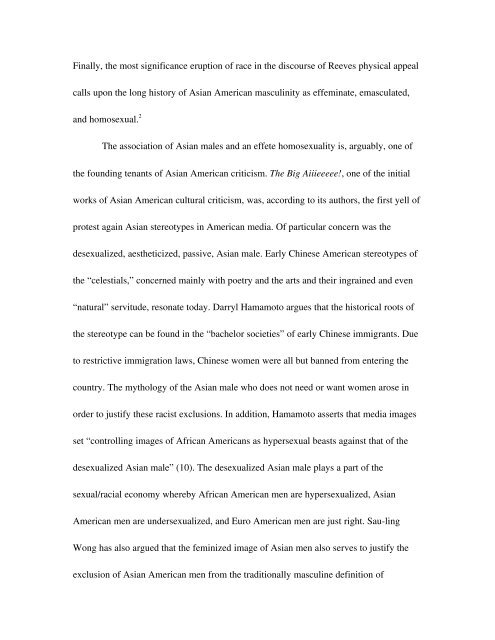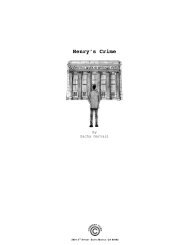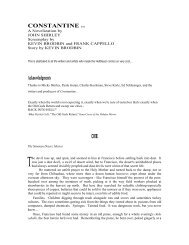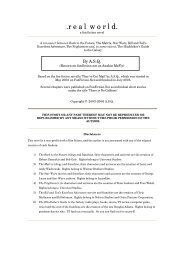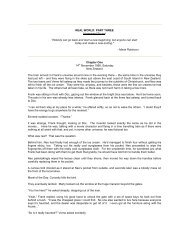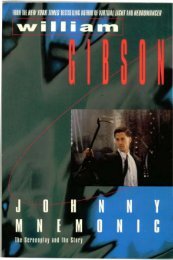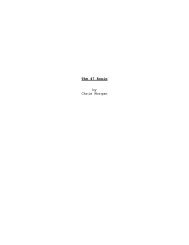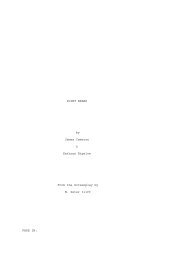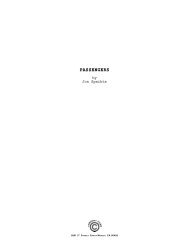Queer Keanu: Race, Sexuality and the Politics of - Whoa is (Not) Me
Queer Keanu: Race, Sexuality and the Politics of - Whoa is (Not) Me
Queer Keanu: Race, Sexuality and the Politics of - Whoa is (Not) Me
Create successful ePaper yourself
Turn your PDF publications into a flip-book with our unique Google optimized e-Paper software.
Finally, <strong>the</strong> most significance eruption <strong>of</strong> race in <strong>the</strong> d<strong>is</strong>course <strong>of</strong> Reeves physical appeal<br />
calls upon <strong>the</strong> long h<strong>is</strong>tory <strong>of</strong> Asian American masculinity as effeminate, emasculated,<br />
<strong>and</strong> homosexual. 2<br />
The association <strong>of</strong> Asian males <strong>and</strong> an effete homosexuality <strong>is</strong>, arguably, one <strong>of</strong><br />
<strong>the</strong> founding tenants <strong>of</strong> Asian American critic<strong>is</strong>m. The Big Aiiieeeee!, one <strong>of</strong> <strong>the</strong> initial<br />
works <strong>of</strong> Asian American cultural critic<strong>is</strong>m, was, according to its authors, <strong>the</strong> first yell <strong>of</strong><br />
protest again Asian stereotypes in American media. Of particular concern was <strong>the</strong><br />
desexualized, aes<strong>the</strong>ticized, passive, Asian male. Early Chinese American stereotypes <strong>of</strong><br />
<strong>the</strong> “celestials,” concerned mainly with poetry <strong>and</strong> <strong>the</strong> arts <strong>and</strong> <strong>the</strong>ir ingrained <strong>and</strong> even<br />
“natural” servitude, resonate today. Darryl Hamamoto argues that <strong>the</strong> h<strong>is</strong>torical roots <strong>of</strong><br />
<strong>the</strong> stereotype can be found in <strong>the</strong> “bachelor societies” <strong>of</strong> early Chinese immigrants. Due<br />
to restrictive immigration laws, Chinese women were all but banned from entering <strong>the</strong><br />
country. The mythology <strong>of</strong> <strong>the</strong> Asian male who does not need or want women arose in<br />
order to justify <strong>the</strong>se rac<strong>is</strong>t exclusions. In addition, Hamamoto asserts that media images<br />
set “controlling images <strong>of</strong> African Americans as hypersexual beasts against that <strong>of</strong> <strong>the</strong><br />
desexualized Asian male” (10). The desexualized Asian male plays a part <strong>of</strong> <strong>the</strong><br />
sexual/racial economy whereby African American men are hypersexualized, Asian<br />
American men are undersexualized, <strong>and</strong> Euro American men are just right. Sauling<br />
Wong has also argued that <strong>the</strong> feminized image <strong>of</strong> Asian men also serves to justify <strong>the</strong><br />
exclusion <strong>of</strong> Asian American men from <strong>the</strong> traditionally masculine definition <strong>of</strong>


